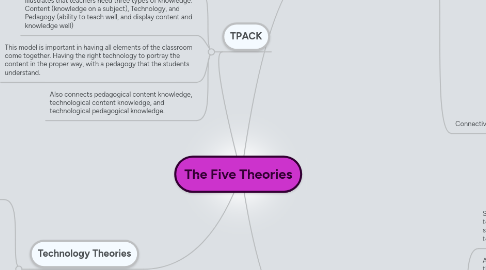
1. Technology Theories
1.1. SCOT
1.1.1. SCOT stands for Social Construction of Technology
1.1.2. Unlike in Media Ecology, people and have influence over the media
1.1.3. Science and Technology field theory
1.1.4. Determines the reasons behind the success or failure of technology
1.1.4.1. Example: HD players vs bluray players. The HD player failed because consumers were more interested in the bluray player.
1.2. Media Ecology
1.2.1. Media is an environment
1.2.2. Sees humans as the ones who are effected by the media and technology
1.2.3. Technology has a strong influence on society
1.2.4. Media Ecology has multiple definitions and is hard to define
2. TPACK
2.1. TPACK stands for Technological Pedagogical Content Knowledge
2.2. Illustrates that teachers need three types of knowledge: Content (knowledge on a subject), Technology, and Pedagogy (ability to teach well, and display content and knowledge well)
2.3. This model is important in having all elements of the classroom come together. Having the right technology to portray the content in the proper way, with a pedagogy that the students understand.
2.4. Also connects pedagogical content knowledge, technological content knowledge, and technological pedagogical knowledge.
3. Learning Theories
3.1. Cognitive Load Theory
3.1.1. Memory is broken into either Long Term Memory or Working Memory
3.1.2. Working memory is the place in your mind that things are processed (thinking) and your awareness, this works hand in hand with long term memory. Working memory takes information and transfers it to long term memory
3.1.3. Long term memory is the place we store all the knowledge we know
3.1.4. Teachers must present knowledge periodically and be aware of how much the students can learn in a class to prevent overload of the working memory
3.2. Constructivism
3.2.1. The learner constructs their own knowledge
3.2.2. An active type of learning
3.2.3. Teacher acts as a mentor rather than an instructor, in the sense that they aid the students in obtaining their own knowledge rather than providing them with the information straight out
3.2.4. Problem and project based learning
3.2.5. One example of this technology would be scratch
3.2.6. Has roots in philosophy, education, psychology, and sociology
3.3. Connectivism
3.3.1. Learning has a goal: which is at the end of the learning you have the ability to do more with that skill and you have the drive to do more.
3.3.2. The knowledge/information is out their for learning to find, they simply must look for it
3.3.2.1. Knowing where to find the information is critical in the learning process
3.3.3. Multiple ways of learning exist past the traditional classroom environment
3.3.4. Dependent on the connections you can make, and the connecting of different nodes
3.3.5. Teachers are there to help the students develop the connections
